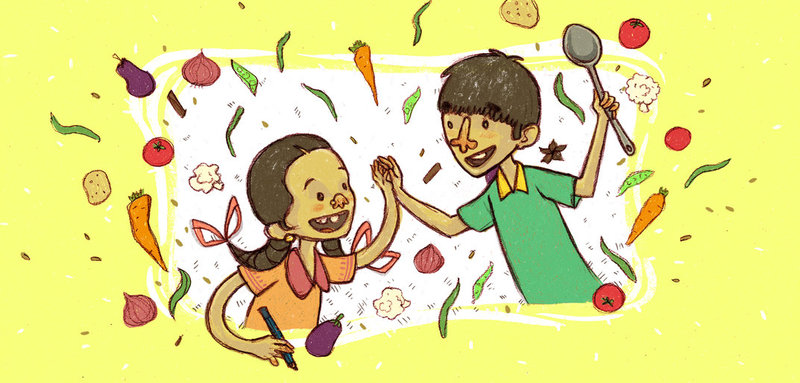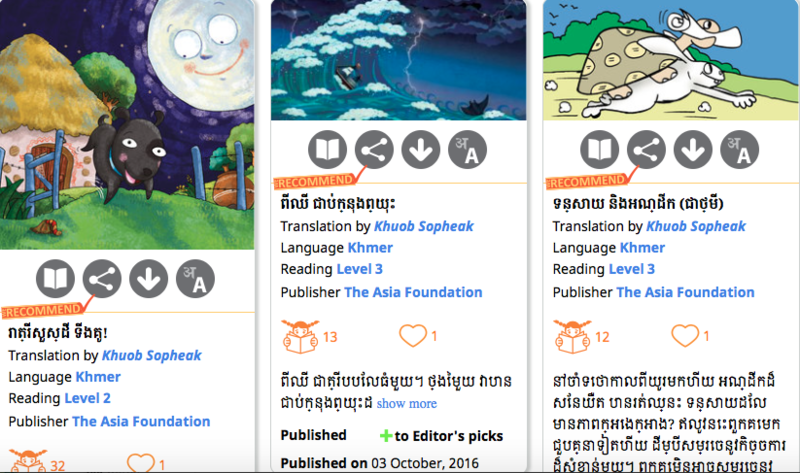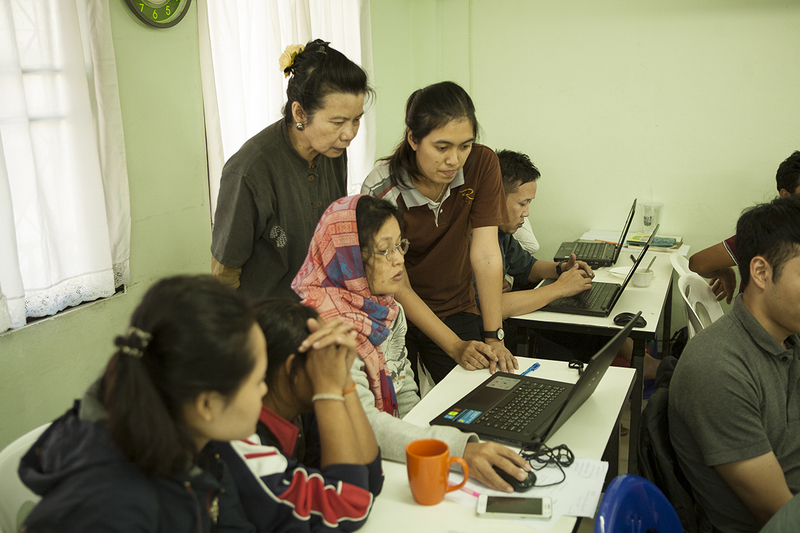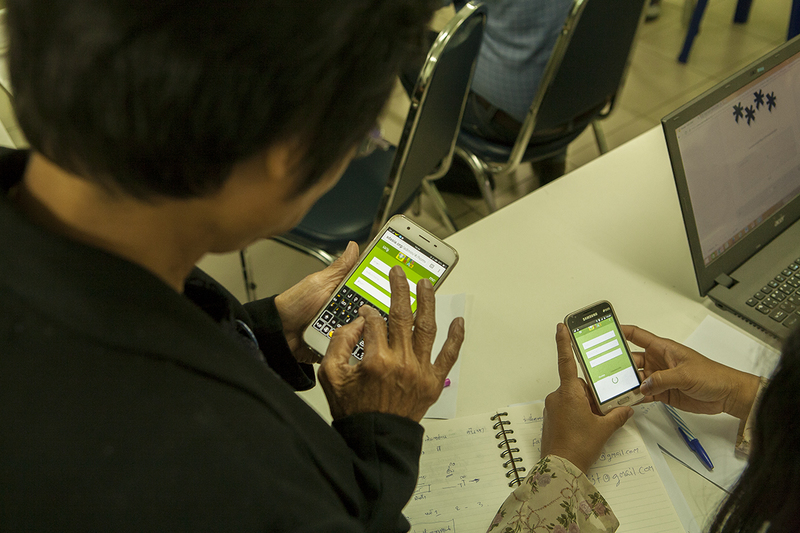ಅಚ್ಚರಿ ಹುಟ್ಟಿಸಿದ ಅದ್ಭುತ ಕ್ರಿಯೆ
Posted by Remya Padmadas on September 30, 2017September 30th is celebrated around the world as International Translation Day. We're very fortunate that some of our wonderful translators and language reviewers shared their thoughts on translation and children's books with us on this occasion.
With 19 years of experience in journalism Shashi Sampalli is indeed our star translator. This father of an 8 year old girl includes literature, the environment and agriculture are his interests. In this piece of writing he speaks on how to balance “maturity and innocence” while writing for children.
ಅನುವಾದ ಎಂಬುದು ಕೂಡ ಒಂದು ಸೃಜನಶೀಲ ಕ್ರಿಯೆ. ಅದರಲ್ಲೂ ಮಕ್ಕಳ ಸಾಹಿತ್ಯವನ್ನು ಅನುವಾದಿಸುವಾಗ ನಾವು ಸ್ವತಃ ನಮ್ಮೊಳಗಿನ ಮಗುವನ್ನು ಮುನ್ನೆಲೆಗೆ ತಂದುಕೊಂಡೆ ಅನುವಾದವನ್ನು ಆ ಮಗುವಿನ ಮೂಲಕವೇ ಆಗಿಸಬೇಕಾಗುತ್ತದೆ. ಎಲ್ಲ ಸೃಜನಶೀಲ ಸಾಹಿತ್ಕಕ್ಕೂ ಒಂದು ಹಂತದ ಮುಗ್ಧತೆ ಅಗತ್ಯ. ಮಕ್ಕಳ ಸಾಹಿತ್ಯದ ವಿಷಯದಲ್ಲಿ ಹೆಚ್ಚು ಮುಗ್ಧತೆ ಮತ್ತು ಕಡಿಮೆ ಪ್ರಬುದ್ಧತೆ ಉತ್ತಮ.
ಸ್ವತಃ ಮಕ್ಕಳ ಸಾಹಿತ್ಯ ರಚಿಸುವಾಗ ಪ್ರಬುದ್ಧತೆಯ ಪ್ರಮಾಣ ಕಡಿಮೆ ಇದ್ದರೂ ನಡೆಯುತ್ತದೆ ಅಥವಾ ಹೆಚ್ಚು ಅನುಕೂಲವಾಗಬಹುದು. ಆದರೆ, ಮಕ್ಕಳ ಸಾಹಿತ್ಯದ ಅನುವಾದ ಅಷ್ಟು ಸರಳವಲ್ಲ. ಅದಕ್ಕೆ ಪ್ರಬುದ್ಧತೆಯೂ ಬೇಕು. ಮುಗ್ಧತೆಯೂ ಬೇಕು. ಆ ಅರ್ಥದಲ್ಲಿ ಇದೊಂದು ತಂತಿ ಮೇಲಿನ ನಡಿಗೆ. ಎರಡೂ ಕಡೆಯ ಸಮತೋಲನ ಇಲ್ಲದೆ ಇದ್ದರೆ ಜಾರುವುದು ಖಂಡಿತ.
ಭಾಷೆ, ಅರಿವಿನ ವಿಷಯದಲ್ಲಿ ಅನ್ಯ ಭಾಷೆ ಮತ್ತು ಹೊಸ ವಿಷಯವನ್ನು ಅರ್ಥಮಾಡಿಕೊಂಡು ಅನುವಾದಿಸುವ ಪ್ರಬುದ್ಧತೆಯೂ ಬೇಕು. ಆ ಅನುವಾದ ಉದ್ದೇಶಿತ ವಯೋಮಾನದ ಮಕ್ಕಳಿಗೆ ಎಟುಕುವಂತೆ ಭಾಷೆ ಬಳಸುವ, ಮಕ್ಕಳ ಮನೋಸ್ಥಿತಿಗೆ ಅನುಗುಣವಾಗಿ ಸುಲಲಿತ ಮಾತುಗಳಲ್ಲಿ ತಲುಪಿಸುವ ಮುಗ್ಧತೆಯೂ ಬೇಕು.
ಈ ಸಮನ್ವಯತೆ ಸಾಧಿಸುವುದು ಸರಳವಲ್ಲ. ಅದಕ್ಕೆ ನಮ್ಮೊಳಗೆ ಒಬ್ಬ ತಿಳಿವು, ಅರಿವಿನ ವಯಸ್ಕನೂ ಇರಬೇಕು, ಜೊತೆಗೆ ಮುಗ್ಧತೆಯ ಮಗುವೂ ಇರಬೇಕು.
ಅನುವಾದಿಸುವ ಮುನ್ನ ನಮ್ಮ ಎದುರಿನ ಕಥೆ ಅಥವಾ ಸಾಹಿತ್ಯ ನಮ್ಮೊಳಗೆ ಇಳಿಯಬೇಕು. ಅನ್ಯ ಭಾಷೆಯ ಅದನ್ನು ಓದಿ, ಒಂದಿಷ್ಟು ಕಾಲ ಒಳಗಿಟ್ಟುಕೊಂಡು ನನ್ನ ಭಾಷೆಯ ಮಾತುಗಳಲ್ಲಿ ಮರು ಕಟ್ಟಬೇಕು. ಅದಕ್ಕಾಗಿ ಮಕ್ಕಳ ಮಾತುಗಳಿಗೆ ಕಿವಿಯಾಗಬೇಕು. ನಂತರ ಅನುವಾದಿಸುವಾಗ ಕೂಡ ಬಳಸುವ ಪ್ರತಿ ಪದವನ್ನೂ ಜೋರಾಗಿ ಉಚ್ಛರಿಸಿ, ಅದು ಮಗುವಿನ ಮಾತಿನಂತೆ ಕೇಳುತ್ತದೆಯೇ? ಪದ ಬಳಕೆ ಮಗುವಿನದ್ದೇ ಆಗಿದೆಯೇ ಎಂಬುದನ್ನು ನಿಖರಗೊಳಿಸಿಕೊಳ್ಳುತ್ತಲೇ ಮುಂದುವರಿಯಬೇಕು.
ನನಗಂತೂ ಒಬ್ಬ ಕವಿಯಾಗಿ ನನ್ನೊಳಗಿನ ಮಗುವಿನೊಂದಿಗೆ ಮಾತಾಡುವುದು ಈ ಕಾರ್ಯಕ್ಕೆ ಒದಗಿಬರುತ್ತದೆ. ಜೊತೆಗೆ ಎಂಟು ವರ್ಷದ ಮಗಳಿಗೂ ಕಥೆ ಓದಿ ಹೇಳಿ ಅವಳ ಪ್ರತಿಕ್ರಿಯೆ ಮೇಲೆ ತಿದ್ದುಪಡಿ ಮಾಡುವ ಅವಕಾಶ ಕೂಡ ಇದೆ.
ಹಾಗಾಗಿ, ಬಿಯಾಂಡ್ ಸೈಟಿಂಗ್ಸ್, ಬೆಸ್ಟ್ ಫೂಟ್ ಫಾರ್ವರ್ಡ್, .. ಚೀನಾಟೌನ್ ಮುಂತಾದ ಕಥೆಗಳು ನನ್ನ ನಿರೀಕ್ಷೆಗೂ ಮೀರಿ ಉತ್ತಮವಾಗಿ ಮೂಡಿಬಂದವು ಮತ್ತು ನನಗೇ ಅಚ್ಚರಿ ಹುಟ್ಟಿಸಿದವು.
ಮುಖ್ಯವಾಗಿ ಅನುವಾದ ಕ್ರಿಯೆಯನ್ನು ಆವು ಮೋಜಿನ ಆಟದಂತೆ ಆನಂದಿಸಬೇಕು.
ಇವು ನನ್ನದೇ ಅನುಭವದ ಮಾತುಗಳು.
- ಶಶಿ ಸಂಪಳ್ಳಿ
Be the first to comment.
We are looking for an Assistant Project Manager to join our team!
Posted by Pallavi Krishnan on December 27, 2018Pratham Books is a not-for-profit children's book publisher that was set up in 2004 to publish good quality, affordable books in many Indian languages. Our mission is to see ‘a book in every child’s hand’ and we have spread the joy of reading to millions of children in India. As a publisher serving every child in India, Pratham Books has always pushed the boundaries when it comes to exploring innovative ways in which to create access to joyful stories and have been fortunate in finding partners to collaborate with who share this vision.
In 2015, Pratham Books' increased its footprint by going digital. As an industry leader, we were one of the first publishers in the country to open license our content. All this content is now available on StoryWeaver, which is a digital platform that hosts stories in languages from India and beyond, so that every child can have an endless stream of stories in her mother tongue to read and enjoy. The stories can be read, translated, versioned or downloaded for free. All stories on the platform are openly licensed.
 Illustration by Kabini Amin from Dum Dum-a-Dum Biryani by Gayathri Tirthapura
Illustration by Kabini Amin from Dum Dum-a-Dum Biryani by Gayathri Tirthapura
We are looking for an Assistant Project Manager - Storyweaver
This position will work closely with the StoryWeaver content team to support the expansion of StoryWeaver’s global language content footprint. The role would involve identifying and nurturing partner relationships for content in languages, supporting core team to maximise partner engagement and support reporting and documentation. Must be someone who has the ability to network and make connections and is up to date with tech and social media trends. They also need to build strong relationships remotely. As nurturing language communities is a key focus area, a love for languages will help in bringing passion and commitment.
Key Responsibilities
- Project level support and coordination across various stakeholders to ensure timely completion of project deliverables.
- Identify and nurture partnership networks for language content.
- Support the core team in follow up on contracts, reporting, documentation and campaign processes.
- Support and facilitate translation workshops for scaling quality language resources on the platform.
- Work closely with the internal teams to implement StoryWeaver’s language goals.
- Help with research and documentation for impact assessment from content partner orgs.
- Contribute new ideas for both the function and platform.
- Support platform feature enhancements through testing.
Required skills
- Proven experience as a Project manager
- Ability to network and make connections
- Excellent organization skills
- Familiar with latest technology, trends in Social Media.
- Excellent communication skills in English and any other Indian language
- Willingness to travel to all project locations
- 1-2 years of experience
Nice to have but not mandatory:
- Interest in languages, communities, books and education
- Social sector experience
- Fluency in the 2-3 languages
Location:
This is a full-time position based out of Bangalore
Compensation:
Salary will be commensurate with qualification and experience.
Write to us:
Email your resume with Assistant Project Manager- Storyweaver in the subject line to [email protected]
Be the first to comment.The Asia Foundation: Taking joyful stories to children in Developing Asia
Posted by Remya Padmadas on February 20, 2017The Asia Foundation is an international nonprofit that helps societies work towards a peaceful, just, and thriving region, and currently works to improve the standard of living across Asia, from Sri Lanka to Mongolia. Improving literacy levels is integral to the work the organisation does, and they have spearheaded a number of programmes across the region to this end.
One such initiative is Let’s Read! which pledges to provide storybooks to children across the continent. “Through technology initiatives and book donations, we help infuse students with a love of reading essential for literacy,” says Melody Zavala, director of the Books for Asia program at The Asia Foundation.
As part their Let’s Read! campaign, The Asia Foundation has created e-libraries that are accessible on any device. "The e-library works in low-bandwidth environments and doesn't require an active internet connection for reading and hence are able to reach children even in areas with poor bandwidth and infrastructure. Books available are in the mother tongue languages of the children. “We know that children learn first and best in their mother tongue. So we want to make local publications available to more children and stimulate their imagination in ways that can only be possible in a local context,” commented Melody.
To provide a wide range of these books, The Asia Foundation used the vast collection of stories available on StoryWeaver. “The translate tool on StoryWeaver attracted us, as once a language (e.g. Thai) is available on the platform, we can get stories translated and provide a large number of quality children’s literature to our partner schools,” shared Melody.
Being able to draw on StoryWeaver titles has been invaluable to the Let’s Read! initiative, shares Melody. The initiative incubates innovative digital, print, and community-based solutions to "improving access to high-quality children’s books in mother tongues and national languages and currently consists of integrated e-book library, translation, and content creation projects.
Stories in Khmer
“So far, we’ve translated 9 titles into Khmer which are all available on StoryWeaver. The stories are also available on our Cambodia project site, along with new stories created in Khmer by local authors and illustrators during our e-book hackathons." informed Melody. "In Cambodia the Ministry of Education’s online education portal will also link to these stories, hence making them available to their 1.5 million followers. he stories will also be made to other Khmer educational apps and projects, including Khmer LEARN, which has 38,000 users, and the Library For All app, which is used in 5 rural schools

Increasing content in ethnic minority languages
In Thailand, StoryWeaver content will be translated as a part of the Let’s Read initiative there that utilizes a suite of integrated smartphone apps – a translation tool and free story reader app - to increase content in ethnic minority languages. A Let’s Read! translation workshop took place in Chiangmai, Thailand where 10 Pratham Books titles from StoryWeaver were translated from Thai into S’gaw Karen. The programme will initially be implemented in 10 villages and positively impact 1,000 children. S'gaw Karen is spoken by over four million S'gaw Karen people in Burma, and 200,000 in Thailand. The Asia Foundation will be using their own Thai translations on StoryWeaver to create joyful reading material in S'gaw Karen. Content translation for programmes in Bangladesh has also been initiated."


Participants at the ChiangMai workshop. Images courtesy Kyle Barker, The Asia Foundation.
You can read the Khmer translations uploaded by The Asia Foundation here. Keep following us on twitter for more updates about our work with them.
Be the first to comment.